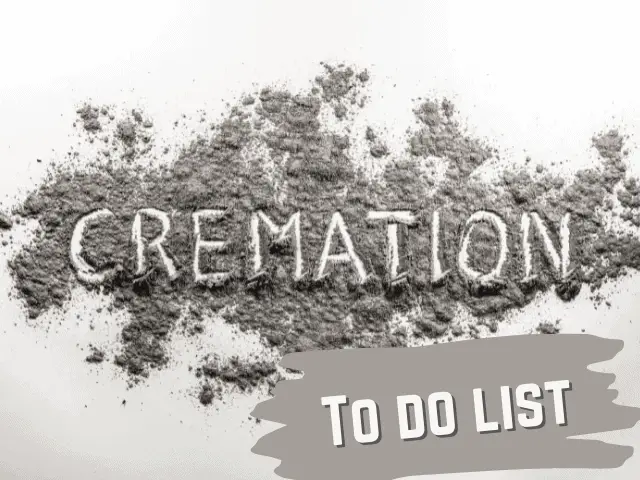Cremations are becoming increasingly common in North America as a means of disposing of the dead. In the next 25 years, 79% of Americans will be cremated, which will bring with it a fair few logistical issues, particularly how quickly it can happen
In most states, the law requires families to wait at least 24 hours before cremation or burial. Otherwise, it can be up to 72 hours. The state retains the right to keep a body when the cause of death hasn’t been determined yet and dispose of it immediately when it poses a health threat to the public
As you have probably never dealt with a cremation, you probably have a few questions about what will happen. In the rest of the article, I will go over some key aspects of cremations and exactly what the law says about when and how quickly they can happen.

Cremation laws by State – When can they happen?
The cremation laws in each state can be very different, and I should know because I spent several hours digesting and condensing the legal language into something easy to understand.
The key thing to remember if you are trying to organize a speedy cremation in your state is that certain things have to happen before you can create a body.

A death certificate must be issued in order for a body to be released to a family. Some states allow for up to 72 hours for this process. Many states allow the cremation (or burial) of human remains after a delay of 24 hours, with a death certificate. Other states insist on at least 48 hours.
There are some states which do not specify an exact delay between death and cremation, but they will allow a coroner at least 24 hours to issue a death certificate.
Also, these regulations can be totally overruled in cases where the body poses a public health risk, in which case it could be disposed of immediately at the discretion of the state.
| US State | Minimum Waiting period before cremation | link |
|---|---|---|
| Alabama | 24 hours | Source |
| Alaska | 24 hours | Source |
| Arizona | 72 hours* | Source |
| Arkansas | 48 hours | Source |
| California | 24 hours | Source |
| Colorado | 24 hours | Source |
| Connecticut | 48 hours | Source |
| Delaware | 24 hours | Source |
| Florida | 24 hours** | Source |
| Georgia | 24 hours** | Source |
| Hawaii | 24 hours | Source |
| Idaho | 24 hours** | Source |
| Illinois | 24 hours** | Source |
| Indiana | 48 hours | Source |
| Iowa | 24 hours** | Source |
| Kansas | 24 hours | Source |
| Kentucky | 24 hours** | Source |
| Louisiana | 24 hours | Source |
| Maine | 48 hours | Source |
| Maryland | 24 hours** | Source |
| Massachusetts | 24 hours** | Source |
| Michigan | 24 hours** | Source |
| Minnesota | 24 hours** | Source |
| Mississippi | 24 hours** | Source |
| Missouri | 72 hours* | Source |
| Montana | 24 hours | Source |
| Nebraska | 24 hours | Source |
| Nevada | 72 hours* | Source |
| New Hampshire | 48 hours | Source |
| New Jersey | 24 hours | Source |
| New Mexico | 24 hours** | Source |
| New York | 24 hours** | Source |
| North Carolina | 24 hours | Source |
| North Dakota | 24 hours** | Source |
| Ohio | 24 hours | Source |
| Oklahoma | 48 hours | Source |
| Oregon | 24 hours** | Source |
| Pennsylvania | 24 hours** | Source |
| Rhode Island | 24 hours | Source |
| South Carolina | 24 hours | Source |
| South Dakota | 24 hours** | Source |
| Tennessee | 24 hours** | Source |
| Texas | 48 hours | Source |
| Utah | 24 hours** | Source |
| Vermont | 24 hours | Source |
| Virginia | 24 hours** | Source |
| Washington | 24 hours** | Source |
| West Virginia | 24 hours** | Source |
| Wisconsin | 48 hours | Source |
| Wyoming | 24 hours** | Source |
| Washington D.C | 24 hours** | Source |
*the state has this long to establish cause of death. ** no specific law but dependent on issuing a death certificate
Key steps in organizing a cremation

Apart from the legal delay imposed on the cremation process by your state, there are more logistical things to think about if you want to organize a cremation quickly. If you don’t want a funeral at all, then you can look into direct cremation (and direct burial).
However, let’s assume that you are planning a cremation as part of a funeral. Below are the main stages in organizing a cremation.
Step 1 : Obtain the death certificate
When a person dies in the USA, they need to be recorded as deceases and this requires a death certificate. When death occurred in a hospital or hospice, the staff will be able to help you to get a death certificate fairly easily. A funeral director can also do this, but there are no laws against filing the document (which is signed by a doctor) yourself. It costs in the region of $25.
Step 2: Meet with a funeral home
For most Americans, you will probably want to work with a funeral home to help you organize the funeral. However, you can save a lot of money by doing a lot of the organizing yourself.
However, if you go down the usual route you will want to select your funeral home and tell them about the death. They will quickly take charge of the situation and start dealing with preparing the body for cremation.
Step 3: Transport the body
When working with a funeral director, they will collect the body and take it to their establishment. As soon as the death certificate is issued, the body can be transported. if you want to do things yourself, you can take the body home from the hospital if you have the right paperwork.
Step 4: Organize the funeral
Although just included in one step, organizing the funeral is a big job. If you want help with planning a funeral and doing it for less, you can find out more information here.
Some of the key jobs are finding a venue for the funeral, contacting friends and relatives, choosing decorations for the funeral, and purchasing items such as caskets and urns.
Just remember that you don’t have to buy a brand new casket to be cremated, you can rent one if you plan to have a viewing. Also, you don’t need to have the body embalmed if you are having them cremated. The body can be preserved by other means and this will save you nearly $1000 in your funeral budget and it’s much better for the environment.
Step 5: The body is cremated
After the funeral has taken place the body will be cremated. This may not happen immediately, but the body will be stored properly until it comes time to carry out the cremation.
Step 6: Ashes are stored or scattered
Once you have been given the ashes by the crematorium, you can decide whether you want to store them in an urn, bury the ashes, either in your yard or in a cemetery, or scatter them. There are many options when it comes to scattering ashes, and you can even think about scattering ashes on a beach. Scattering ashes at sea is also an option if the deceased had any connection to the ocean.
Another great option is to get the ashes made into a permanent piece of jewelry, you should check out the beautiful handcrafted pieces Mark Hamilton makes with cremains by visiting his site here.
I recently looked into getting a loan and I’ve actually had a good experience with Supermoney.com. For me, it was a car loan but I spoke to them about a dedicated funeral expenses loan, which is one of the services they offer, and was quite impressed. To see if you could qualify, check out my link here.
The maximum time you can put off a cremation
There is no legal time frame in which you have to conduct a cremation in the USA, but you would be prosecuted if you didn’t dispose of remains properly, which would include trying to cremate a body at home.
Most states do have a law that requires funeral homes, or whoever is taking care of the body, to refrigerate them if burial or cremation doesn’t occur within 24-30 hours after collecting the cadaver. Failure to do so would be breaking the law.
Then, it becomes a question of how long you are able to store the body in the morgue or similar facility. Hospitals will normally allow a body to be stored for a number of days before it is collected by a funeral home, depending on the space available.
A body can be stored at cool temperatures for several weeks before decomposition becomes too extensive for an open casket funeral. Also, according to Daniel Weeden, a well-embalmed cadaver can last for decades if stored at the right temperatures.
How long does a cremation ceremony take?
A cremation ceremony usually takes under an hour and that really depends on the funeral service and what is included in it. If more people are asked to speak or there are musical performances the service will be longer. If it is a small affair with a brief eulogy, it could take only 20 to 30 minutes.
How long does it take to cremate a body?
The time it takes to cremate a body depends on the capacity of the crematorium and the size of the deceased. Cremation rarely happens directly after a funeral ceremony. The body is normally taken to a storage area and prepared for cremation, which may include transferring them into a different casket for cremation and placing a stainless steel identity plaque in with the body for later.
Once placed in the cremator, the process will take somewhere between 1-4 hours which includes reducing the body tissue to gas, which escapes the incinerator and processing the remaining bones into dust.
How long does it take to get a loved one’s ashes?
The exact times it takes to be given the ashes of your deceased loved one really depends on how busy the crematorium is. However, a delay of up to 10 days is fairly normal. Do not expect to be walking out of the funeral with your Mom or Dad’s ashes.
Although you are given the ashes in an urn, it is usually not one that you could store or bury your loved one in. So, consider purchasing your own urn, especially if you are considering scattering the ashes in any way. Below are some recommended urns you can find on Amazon.
Biodegradable Cremation Urns for Adult Ashes

Buy this on Amazon by clicking the link
Bios Biodegradable Cremation Urn for Humans

Buy this on Amazon by clicking the link
Bamboo Cremation Scattering Urn

Buy this on Amazon by clicking the link
Biodegradable Urn (Floating burials)

Link to Amazon
Eco Scattering Urn

Link to Amazon
Biodegradable Urn For Scattering

Link to Amazon
Also, don’t forget that you can turn those ashes into a memorable piece of jewelry that combines a traditional artistic method with cremains. Check out the beautiful handcrafted pieces Mark Hamilton makes with cremains by visiting his site here.




